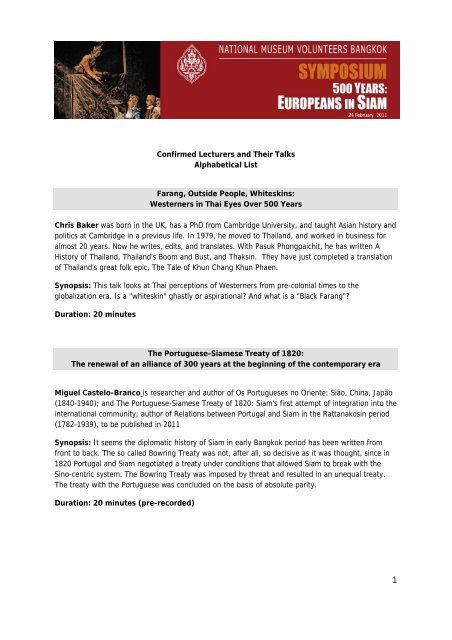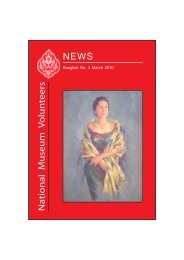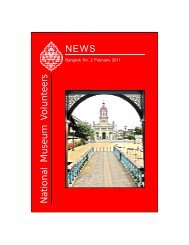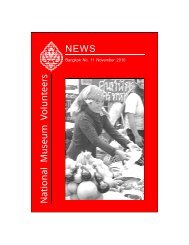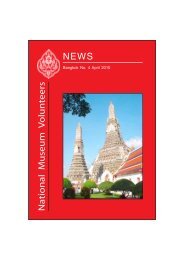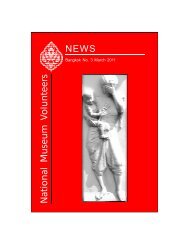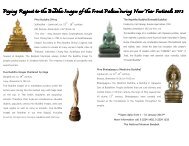details - National Museum Volunteers
details - National Museum Volunteers
details - National Museum Volunteers
Create successful ePaper yourself
Turn your PDF publications into a flip-book with our unique Google optimized e-Paper software.
Confirmed Lecturers and Their Talks<br />
Alphabetical List<br />
Farang, Outside People, Whiteskins:<br />
Westerners in Thai Eyes Over 500 Years<br />
Chris Baker was born in the UK, has a PhD from Cambridge University, and taught Asian history and<br />
politics at Cambridge in a previous life. In 1979, he moved to Thailand, and worked in business for<br />
almost 20 years. Now he writes, edits, and translates. With Pasuk Phongpaichit, he has written A<br />
History of Thailand, Thailand’s Boom and Bust, and Thaksin. They have just completed a translation<br />
of Thailand’s great folk epic, The Tale of Khun Chang Khun Phaen.<br />
Synopsis: This talk looks at Thai perceptions of Westerners from pre-colonial times to the<br />
globalization era. Is a "whiteskin" ghastly or aspirational? And what is a "Black Farang"?<br />
Duration: 20 minutes<br />
The Portuguese-Siamese Treaty of 1820:<br />
The renewal of an alliance of 300 years at the beginning of the contemporary era<br />
Miguel Castelo-Branco is researcher and author of Os Portugueses no Oriente: Sião, China, Japão<br />
(1840-1940); and The Portuguese-Siamese Treaty of 1820: Siam's first attempt of integration into the<br />
international community; author of Relations between Portugal and Siam in the Rattanakosin period<br />
(1782-1939), to be published in 2011<br />
Synopsis: It seems the diplomatic history of Siam in early Bangkok period has been written from<br />
front to back. The so called Bowring Treaty was not, after all, so decisive as it was thought, since in<br />
1820 Portugal and Siam negotiated a treaty under conditions that allowed Siam to break with the<br />
Sino-centric system. The Bowring Treaty was imposed by threat and resulted in an unequal treaty.<br />
The treaty with the Portuguese was concluded on the basis of absolute parity.<br />
Duration: 20 minutes (pre-recorded)<br />
1
European Education of the Thai Elite<br />
M.R. Chakrarot Chitrabongs is the grandson of Prince Naris and Prince Damrong, half-brothers of<br />
King Chulalongkorn. Sent to the UK when thirteen, he returned at thirty, after undergoing English<br />
public school and university education, and professional architectural training. He is one in the last<br />
generations of Thai elite who had the opportunity to be educated comprehensively in Europe. On his<br />
return, he joined the Government Service as teacher of European Art History, before being<br />
transferred to a variety of duties in officialdom. The zenith of his career was his Royal Appointment as<br />
Secretary General of the <strong>National</strong> Culture Commission and Secretary General of the Ministry of<br />
Culture. After retirement, he has devoted himself to teaching in higher education.<br />
Synopsis: The educational system for the Thai elite – the children of the royalty and the nobility –<br />
underwent drastic transformation during the middle Ratanakosin Period during the reigns of Kings<br />
Rama IV (r.1809-1868) and Rama V (r.1868-1910). Prior to this period, the traditional education had<br />
consisted of tutorship using the Buddhist religious texts for lessons in literacy and knowledge. The<br />
reform was led by King Rama IV, while ordained as a Buddhist monk and before his accession to the<br />
throne, who educated himself with European academy achieving proficiency in English, Latin and<br />
Astronomy. Subsequently, as sovereign king, he arranged for his own children to be educated under<br />
the guidance of European nationals hired for the purpose of educating members of the Royal Court.<br />
When King Chulalongkorn came to the throne as a juvenile king, he proceeded to educate himself by<br />
visiting the neighbouring states that were under European rule to see for himself the advances in<br />
modernisation that European education and culture could bring to Southeast Asia. He then decided to<br />
send all of his male offsprings to the European states to be educated. The royalty were soon followed<br />
by the children of the nobility and a new tradition for a European education for the elites of the Thai<br />
society was born.<br />
This paper presents an account of the state of the elitist education prior to the onset of European<br />
education, the early stages of European education of the royalty and subsequent opportunities for the<br />
upper-classes and scholarship winners. There will be also some information on the successes of the<br />
European educated individuals in their subsequent livelihood in the home country.<br />
Duration: 20 minutes<br />
The Politics of Dressing Up<br />
M.L. Chittawadi Chitrabongs was trained as a Thai architect. Her realized work is a set of<br />
lavatories in Chulalongkorn University. On a scholarship from the Thai Government she received her<br />
MA and PhD in History and Theory of Architecture from the Architectural Association School of<br />
Architecture in the UK. Her entry in the first ‘Thai Fashion Competition’ held by the Thai Embassy in<br />
London won second prize. She presented her paper on Crematoria at the 7 th International Conference<br />
on Death, Dying and Disposal at the University of Bath in 2005 and published her essay on The<br />
Politics of Dressing Up in 2010. She has been teaching on the Faculty of Architecture, Chulalongkorn<br />
University, since 2010.<br />
Synopsis: This presentation is based on research for her PhD thesis which documented a process of<br />
hygiene reforms carried out by King Rama V of Siam (who reigned from 1868 until 1910) and her<br />
Thai ancestors. The work depended on access to the King’s manuscripts from the royal archives<br />
which made it possible for the thesis to construct the following arguments. King Rama V was aiming<br />
to increase the royal authority in Bangkok by imposing his ideas of order and neatness. The fact that<br />
2
these were anti-traditional was precisely why his reforms provoked much opposition. It was not just<br />
that King Rama V wished for the Siamese to be clean and tidy, he wanted to be able to mould his<br />
household and, by extension, the inhabitants of Bangkok. King Rama V had wished to break the<br />
Siamese habits, especially where they manifested themselves as eyesores. In order to do this, he was<br />
willing to import and to use contemporary objects and practices (such as Englishmen’s hats and<br />
western tailoring). But one should not read King Rama V’s reforms as ‘westernization’. Within this<br />
lecture she will suggest the idea that the bowler hat represented a highly developed fantasy<br />
connected to the return of King Rama V as a fatherly ghost.<br />
Duration: 15 minutes<br />
The Russian Connection with Siam:<br />
From Tsar Nicholas II to Vladimir Putin<br />
Ines Ehrlich is a freelance feature writer who has written on Thailand’s art, history and architecture.<br />
Synopsis: A quick review of the unique ties formed between the Tsar of Russia and King<br />
Chulalongkorn that proved instrumental in staving off colonization of Siam and preserving its<br />
sovereignty. In 1897 King Chulalongkorn viewed the situation of territorial losses so potentially<br />
serious that he embarked on a grand European tour hoping to establish "balancing" friendships with<br />
as many European nations as possible. Much of the success achieved during the King’s nine month<br />
journey can be attributed to his friendship with Tsar Nicholas II, a relationship forged during the<br />
Tsarevich's state visit to Siam in 1891, before becoming the Tsar of Russia. The Tsar’s genuine<br />
friendship with the King influenced his European counterparts to accept the Siamese King as a royal<br />
equal. The King’s visit to Russia marked the beginning of diplomatic relations between The Romanov<br />
Dynasty and Siam, which later developed to the point that France and other world powers<br />
relinquished their attempts at Siam’s sovereignty.<br />
Duration: 10 minutes<br />
Constantine Phaulkon – Falcon , Facts and Fiction<br />
Alain Forest , Professeur, Université Paris-Diderot/Paris 7, is author of “Falcon, L’Imposteur de<br />
Siam” and “Cambodge: Histoire et Religion” to be published in 2011.<br />
Synopsis: The life of Phaulkon cannot be covered in ten minutes. But, Prof. Forest will give a brief<br />
overview about reality and legends of this fascinating man that could be taken a role model for a<br />
successful career in Siam and a globalized world.<br />
Duration: 10 minutes (pre-recorded)<br />
The French in Siam<br />
Claire Keefe-Fox was born in Italy, grew up in the United States, France and Italy, and attended<br />
university in England, Italy, Switzerland and France. Working as an interpreter since 1975, she was<br />
official interpreter to the French Government until 2009. Her first book, Le Ministre des Moussons,<br />
about Phaulkon, occasioned her participation in "Bouillon de Culture", the most prestigious cultural<br />
program on French television. She has since written other books that have won recognition, some of<br />
3
which have been translated into Thai and sold well ; and she is currently writing The Tears of Siam.<br />
She is at present Director of Alliance Française for Thailand.<br />
Synopsis: In the 17 th century, according to archival sources, the first French to venture to Siam<br />
were Jesuits and, shortly after, members of the “Missions Etrangères de Paris”, who established<br />
themselves in Ayudhya and recounted the trials and tribulations of dealing with a new, unsettling<br />
culture and a well established religion.<br />
In this age of exploration and first attempts at creating global trade networks, merchants and<br />
diplomats followed, the latter with far from unqualified success as is well known from the thoroughly<br />
documented embassy sent by King Louis XIV to the court of King Narai in 1685.<br />
After the hasty withdrawal of the French mission and troops following the “Revolution of Siam” of<br />
1688, the missionaries were left behind to fend for themselves, until the end of the 19 th century,<br />
when Siam became a pawn in the great power play of colonial empire building and the quest for raw<br />
materials, the French largely ignored the scene of their first attempt—and failure—to establish a<br />
foothold in Asia.<br />
Faced with the “Parti Colonial” becoming ever more powerful in France, and greedy for more Asian<br />
colonies to bolster the Indochinese possessions in the East, along with the encroaching British<br />
Empire on its western and southern borders, Siam was forced into a difficult balancing act between<br />
dangerous neighbors, the need to modernize, and threats to its independence.<br />
But shared danger creates unity, and although the kingdom did not emerge unscathed, it was<br />
nonetheless able to weather the storm and face the challenges of the 20 th century with defined and<br />
recognized borders, and more importantly still, a sense of nationhood.<br />
Duration: 20 minutes<br />
German traces of one of the oldest corporate citizens in Thailand:<br />
B.Grimm’s more than 130 years of doing business with compassion<br />
Harald Link joined B.Grimm in 1978 after receiving an MBA at the University of St. Gallen,<br />
Switzerland. In 1987 he was appointed Chief Executive and is currently serving as Chairman of the B.<br />
Grimm Group.<br />
Synopsis: A German by descent, Harald Link finds himself curiously reflecting a Thai sensibility<br />
filtered through his German upbringing: “I feel Thai but at the same time have strong German roots.”<br />
In his talk, Harald Link explores the unique standpoint of the B.Grimm Group in Thai history.<br />
Established in 1878 as one of the first German firms to be incorporated in Thailand, B.Grimm stands<br />
as a diversified business corporation with roots irrevocably entwined with Thailand and its people.<br />
B.Grimm is very German yet very Thai, something reflected in the company’s very purpose: doing<br />
business with compassion for the development of civilization. Expect a fascinating journey from the<br />
first Western medicine for the Kingdom to pioneering into private power plants and teaching children<br />
about science.<br />
Duration: 20 minutes<br />
The first Europeans in Siam – the Portuguese<br />
Giacomo (Jack) Mauri, President of the Dante Alighieri Association of Bangkok was a former<br />
business executive with Exxon Corporation with postings in the United States, Japan and Thailand.<br />
After retirement, he returned to Bangkok and taught marketing at Thammasart University. He has<br />
reverted back to an old passion for history and culture. Over the past seven years, he has conducted<br />
4
esearch on 16 th century Siamese history in a programme at Chulalongkorn University, relying largely<br />
on a collection of Portuguese documents at Cornell University.<br />
Synopsis: The Portuguese laid siege to Malacca in 1511 under the command of Admiral Afonso<br />
D’Albaquerque and immediately sent an envoy to Ayutthaya to establish relations with Siam – the first<br />
time in history that a European had been received in Siam (Ayutthaya).<br />
In their quest to establish a direct route by sea from the spice producing areas of Southeast Asia and<br />
thereby to bypass complex land and sea routes controlled by Middle Eastern and Venetian merchants,<br />
the Portuguese had managed to navigate around the Southern tip of Africa and get to India just a<br />
few<br />
The spice trade was an extremely lucrative trade that strongly appealed to small, impoverished<br />
Portugal. What did the Portuguese seek in their mission to Ayutthaya? Significantly, Duarte<br />
Fernandez, the first Portuguese envoy, travelled to Ayutthaya aboard a Chinese merchant vessel, not<br />
a Portuguese warship. The Siamese responded favorably, seeking in turn better firearms from the<br />
Portuguese. Various types of Portuguese were involved in 16 th century Siam: conquerors, traders,<br />
mercenaries and missionaries. Jack’s presentation will briefly describe their types and their<br />
successes, or lack thereof.<br />
But were the Portuguese really the first Europeans to reach Siam? Meet two Italians: Nicolo’ De’<br />
Conti and Ludovico De Varthema.<br />
Duration: 20 minutes<br />
Italians at the Court of Siam<br />
Prof. Paolo Piazzardi, is former Cultural Attaché at the Italian Embassy in Bangkok and co-author<br />
of Italians at the Court of Siam<br />
Synopsis: Between the end of the 19th century and the early 20th an outstanding community of<br />
Italian architects, engineers, artists and artisans gave their skills to make Bangkok the modern capital<br />
of the kingdom.<br />
The protagonists of this fascinating story are portrayed in this Symposium, with a stress on their<br />
private lives, as in the book ‘Italians at the Court of Siam’, a human document rather than a treatise<br />
on their artistic styles.<br />
Duration: 20 minutes (pre-recorded)<br />
Living the Dangerous Dutch Life in Ayutthaya<br />
Bhawan Ruangslip obtained her doctoral degree in history at Leiden University and is currently a<br />
lecturer at the History Department, Faculty of Arts, Chulalongkorn University. She is the author of<br />
Dutch East India Company Merchants at the Court of Ayutthaya: Dutch Perceptions of the Thai<br />
Kingdom, c. 1604-1765 (Leiden: Brill, 2007).<br />
Synopsis: The Dutch East India Company (VOC) arrived in Ayutthaya in 1604. Originally considering<br />
the Siamese capital and port city as a stepping stone for reaching China, the Dutch merchants found<br />
potential benefits in Siamese goods, and decided to open a trading post.<br />
5
During their 160 years in Ayutthaya, they were traders, diplomats, courtiers, as well as employers,<br />
parents and community members who needed to understand not only the local pattern of commerce<br />
but also the Kingdom’s political situation, socio-cultural conditions and interpersonal relationships.<br />
Duration: 20 minutes<br />
Are the longstanding Thai-Portuguese relations connected with the popular Thai dessert<br />
Foi Thong?<br />
Bulong Srikanog, of the Division of Literature and History of the Fine Arts Department is a<br />
documentary scriptwriter and lecturer on Thai History and Thai Studies at Silpakorn University and<br />
Chulachomklao Royal Military Academy, and is currently involved in The Research Project of Thai-<br />
Portuguese Relations.<br />
Synopsis: When Portugal is mentioned among Thais, the image that a surprising number of them<br />
come up with is foi thong, or “golden threads”, a Thai dessert made of egg yolks and sugar, having<br />
its roots in Portugal. This reflects the long existence of this dessert in Thai life and culture, since foi<br />
thong is usually found in major traditional events and ceremonies all year round. In a wedding<br />
ceremony, for instance, it is served as a symbol of lasting love and happiness. Using evidence from<br />
old documents, historical records, and significant sites spanning from Lisbon to Ayutthaya, this lecture<br />
will examine many aspects of Thai-Portuguese relationships.<br />
Duration: 20 minutes<br />
Chao Phya Abhai Raja Gustave Rolin-Jaequemyns,<br />
General Adviser of H.M. King Chulalongkorn<br />
Count Gerald van der Straten Ponthoz hails from a Belgian aristocratic family whose members<br />
include many important figures. The ancestry of Phya Abhai Raja Gustave Rolin-Jaequemyn can be<br />
traced back to his grandmother’s family tree. He is the founder and Chairman of the Chao Phya Abhai<br />
Raja Siammanukulkij Foundation.<br />
Synopsis: Meet Gustave Rolin-Jaequemyns, who devoted nearly a decade of his life to the service<br />
of King Chulalongkorn. He loyally served the visionary king as General Adviser between 1892 and<br />
1901. His main responsibilities were to reform the judicial system and develop the administration of<br />
Siam. He worked with the utmost honesty for the progress of Siam and was very trusted by His<br />
Majesty who invested him with the title of Chao Phya Abhai Raja Siammanukulkij, which was the<br />
highest title that a foreigner had ever received.<br />
Duration: 10 minutes<br />
Putting the Golden Land on the Map<br />
Thavatchai Tangsirivanich, Thailand's leading map connoisseur and author of Ayutthaya in<br />
European Maps, studied International Relations at Warwick and Oxford Universities. He was ASEAN<br />
6
Research Fellow at the Institute of Southeast Asian Studies in Singapore and Visiting Fellow at the<br />
Japan Institute of International Affairs. His interest in cartography began when he discovered an 18th<br />
century French plan of Ayutthaya. Since then, he has devoted himself to collecting and researching<br />
old European maps of Siam, sharing his knowledge through public lectures, interviews, articles and<br />
books. Many have shown great interest in his expertise and the appreciation for the western<br />
cartography of Siam has been considerably augmented.<br />
Synopsis: The Land and Kingdom of Siam impinged largely on the Western imagination. It is<br />
referred to in the classical literature as Aurea Regio, a Land of Gold. Khun Thavatchai will begin with<br />
a rare text and maps which depict the kingdom as such. He will then retrace the development of<br />
European mapping of Siam starting from the mid-15th century when the Kingdom was first depicted<br />
on the Fra Mauro's world map, guiding us through various cartographic changes, and conclude with<br />
Bartholomew's Burma and Farther India, the first map produced after the 1909 Anglo-Siamese<br />
Treaty. European fascination with the kingdom and its cultures is clearly evident in the cartouches<br />
and vignettes decorating many of the maps. In addition to their scientific and artistic values, these<br />
maps are contemporary evidence of European contacts with Siam. Expect fascinating discoveries<br />
including the famous mythical lake 'Lago de chiamay' (Chiang Mai Lake?). Fanciful bird's-eye views of<br />
Ayudhya, Siam’s former capital, will also be featured. Throughout the presentation, the audience will<br />
be exposed to, and hopefully captivated by, the diverse range of visual records of the Kingdom's<br />
illustrated history.<br />
Duration: 20 minutes<br />
John Toomey, NMV member<br />
Top 10 European Farang in Siam<br />
Synopsis: American and, thus, impartial John Toomey took on the “hot seat”, along with two other<br />
non-European sub-committee members, to organize and chair the election of the “Top Ten European<br />
Farang in Siam/Thailand". The voting will take place during the morning of the NMV-Symposium by<br />
all attendants and results will be announced before the end of the event. Every vote counts…<br />
Duration: Two ten minute slots, totaling twenty minutes, plus one 5-10 minute session announcing<br />
the results. (Total 30 minutes)<br />
Representative Highlights from the European Collection of the<br />
<strong>National</strong> <strong>Museum</strong>, Bangkok<br />
John Toomey et al,<br />
Duration: 10 minutes<br />
7


